The big mystery behind the fourth season of Star Trek: Discovery is unknown species 10-C, the extra-galactic makers of the dangerous Dark Matter Anomaly (DMA). We got our first hints about the nature of 10-C in the latest episode, “Rosetta,” and we see indications that 10-C may be inspired by an idea from famed scientist Carl Sagan.
The 10-C are giants
In “Rosetta,” Captain Burnham leads a landing party to an unknown alien planet, believed to be the original homeworld of Species 10-C. The dead planet was described as the solid core of a former gas giant, which had been destroyed by a series of massive asteroids, burning away the atmosphere a millennia before. They only find ruins along with some massive bones.
Of the bones, Dr. Culber says:
It looks like the bone structure is of unusually low density. Before it was fossilized, it would’ve been flexible, almost like cartilage. Their physiology was perfectly adapted for floating in gas layers.
Exploring the planet revealed that 10-C had an unusual form of communication using a variety of hydrocarbon gasses, also known as “organic molecules.” The Discovery crew found a total of 16 different unique hydrocarbons that conveyed different emotional states.
The sole remaining structure on the surface was a nursery, and within that were husks of a number of floating objects. These are possibly the fossilized remains of more of the 10-C.
Something new in Star Trek
All indications from “Rosetta” is that Species 10-C is not tied to previous canon. Gas giant creatures that communicate via organic molecules is something different for Star Trek, which is what executive producer Michelle Paradise said was their goal in a Twitter Spaces discussion last month:
It was very interesting for us in the [writers’] room to create a species somewhat unlike any we’d seen and to build mystery around the species… It’s unlike anything we’ve done on the show before. And it’s unlike a species we’ve seen before.
Today Paramount+ posted about the mysterious nature of 10-C in a new social media post, emphasizing the floating objects.
A mysterious new planet beyond the reaches of our very galaxy! Would you be brave enough to set foot on it? #StarTrekDiscovery pic.twitter.com/dBvbXyE5qr
— Star Trek on Paramount+ (@StarTrekOnPPlus) March 6, 2022
Sagan’s floaters
While new to Star Trek, the concept of creatures that could live in gas giant planets like Jupiter has been proposed before. In 1976, three years after Pioneer 10 did a flyby of Jupiter revealing details of the gas giant’s atmosphere, astrophysicist and astrobiologist Carl Sagan and physicist Edwin Salpeter published a paper titled “Particles, Environments and Possible Ecologies in the Jovian Atmosphere,” which proposed a scientific basis for the possibility of life on Jupiter.
The paper outlined three types of life, dubbed hunters, floaters, and sinkers. The floaters resembled massive jellyfish described as “living balloons” that could grow to be the size of cities, which sounds a bit like what Dr. Culber described after assessing the fossils on the 10-C homeworld. In 1978, as Sagan was preparing his landmark series Cosmos, he commissioned artist Adolph Schaller to paint some of these concepts.
In 1980 Sagan outlined the potential gas giant ecosystem in the second episode of Cosmos, “One Voice in the Cosmic Fugue.” Here he lays out what life can be like, which includes his concept of floaters:
Vast living balloons could stay buoyant by pumping heavy gases from their interiors or by keeping their insides warm. They might eat the organic molecules in the air or make their own with sunlight. We call these creatures floaters. We imagine floaters kilometers across enormously larger than the greatest whale that ever was…beings the size of cities.
You can watch the segment below.
Clarke’s Medusans
Actually, before Cosmos, legendary science fiction author Arthur C. Clarke explored the idea of life in the clouds of Jupiter in his Nebula Award-winning novella A Meeting with Medusa, which first appeared in Playboy Magazine in 1971. Clark returned to the idea in his 1982 novel 2010: Odyssey Two with primitive balloon creatures called Jovians who lived in Jupiter’s atmosphere and could communicate instinctually via radio.
Say hello to 10-C?
While the Discovery team has strived to come up with something new for mysterious species at the heart of season four, it’s possible they were at least inspired by the great scientific visionary Carl Sagan, and possibly Arthur C Clarke as well. However, there is much more to the mystery of 10-C, like their motivation and their history. Communicating with these floating creatures will likely prove to be a challenge, but the crew of the USS Discovery still has two more episodes in which to figure that out.
Sagan Trek
If Discovery was inspired by Sagan, it wouldn’t be the first time; in fact, there was another connection on the other Star Trek episode that debuted the same day as “Rosetta.” The USS Stargazer from Star Trek: Picard’s “The Star Gazer” is a Sagan-class ship. And two decades ago, the Enterprise episode “Terra Prime” featured a monument to Sagan on Mars.
Keep up with the Star Trek Universe at TrekMovie.com.

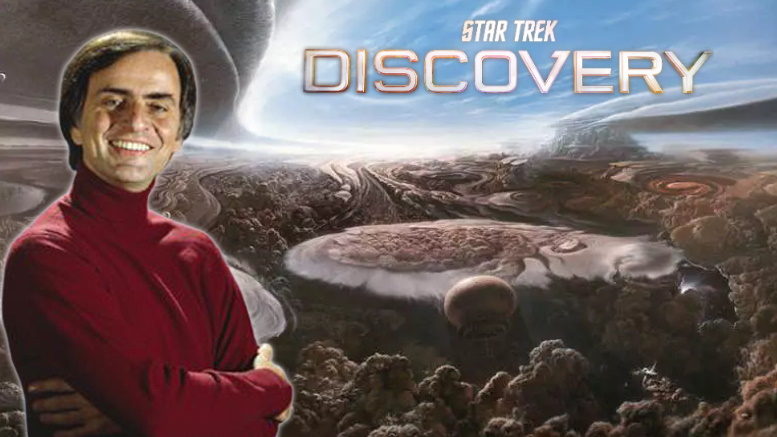
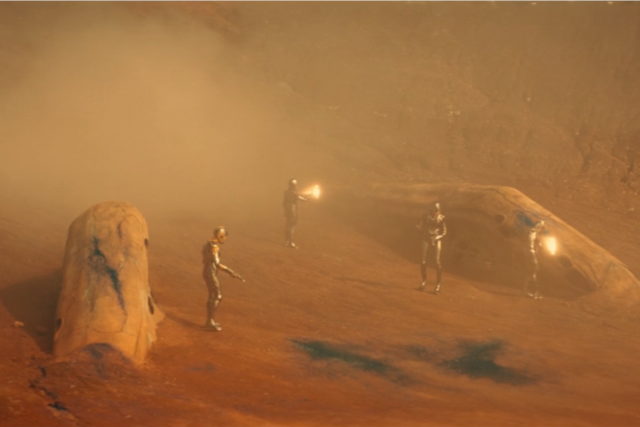
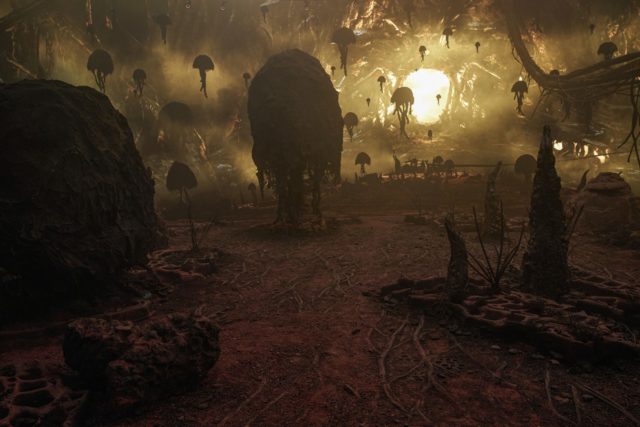
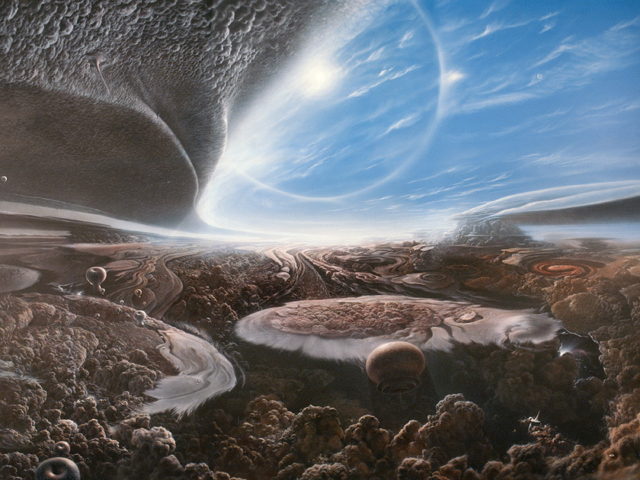
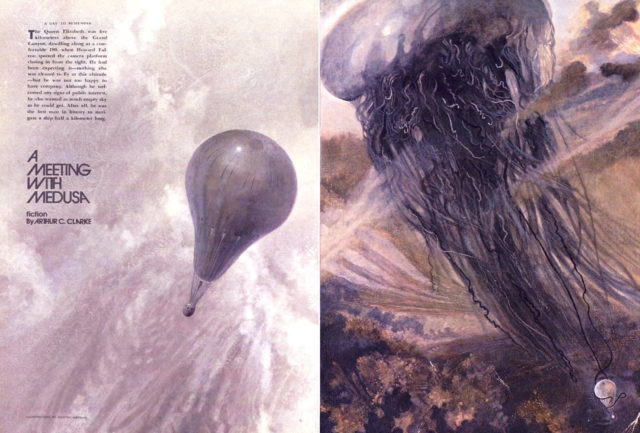
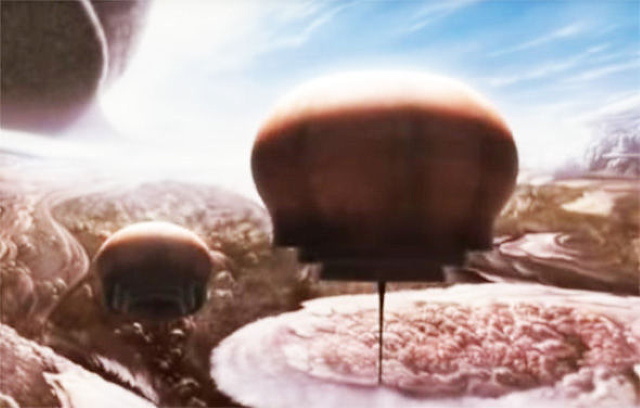
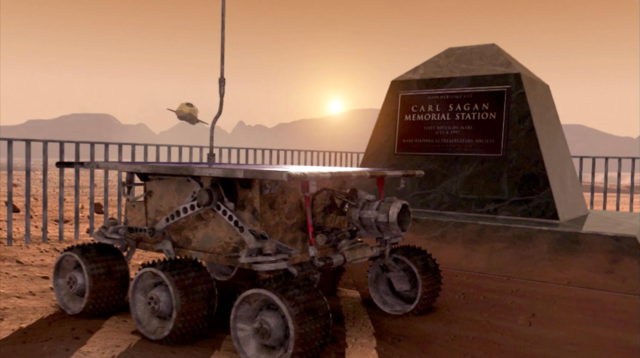



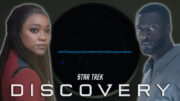
I suspect Book may somehow prove pivotal to communicating with 10-C. Perhaps they’ll pick up on the pain from the loss of his people and planet and stop the DMA. However, I hope the solution isn’t as simple as that.
They did play up his Doctor Doolittle-like ability to communicate with non-humanoid creatures in the season 3 opener that introduced Book. They have never really followed that up, so what you speculate could make narrative sense.
Or Grudge escapes from Burnham’s quarters, runs into the 10-C who we see are giant mice that are absolutely terrified of cats, and 10-C flees, saving Earth and Nivar.
That would be a lot closer to the “boy crying for his Mommy” explanation we got for The Burn.
If so, that’s pretty cool. I’ve always wanted Trek to show some wild aliens and environments like that, but (apart from TAS and TMP) there’s never really been the budgetary means to do so. That’s not true anymore, though, so hopefully we’ll get to see some imaginative stuff like that in these shows going forward.
the movies have just lacked interest in doing that, despite healthy budgets.
Because, doing things like that Giant Alien Creatures, En Masse, can sometimes negatively affect the health of those budgets!
The thing is that you can easily put an actot in Klingon makeup and sell things like “he is angry” “he is amused”…
It is a tougher challenge to make a Sagan’s Floater look angry because we have little to no common ground.
Daleks are of the few non human aliens on regular TV, and it is a miracle their puppeteers manage to put so much emotion on them.
As Spock might say, fascinating! I never heard of these theoretical beings until now. It would be great to see something truly exotic in Star Trek. We gets lots of strange new worlds and civilizations in Star Trek but it’s rarely beyond humanoid or aliens with mostly cosmetic differences but they still look and act mostly human. I know its done for practical and budget reasons but that’s always disappointed me, especially with the films. That’s the time Star Trek can go bigger and get a bit more ‘alien’ in the extreme sense of the word. But it usually comes down to another story about a psycho or group trying to wipe out the Federation or get their hands on a weapon. Season 4 of Discovery has been a very mixed bag for me but it would at least be nice we got something truly cosmic and otherworldly for a change.
Always loved that memorial of Sagan on Enterprise!
First non humanoid alien on Star Trek… The Horta.
Close seconds Gomtuu and the crystaline entity.
Are these the same creatures from Picard in that vortex?
No
We’ll see…
Those creatures in Picard were mechanical
In Picard those species were machines living in a faraway galaxy. That’s why they needed the Synths to open a wormhole. 10c lives just outside our galaxy and they obviously have no problem entering if they want.
Every season people constantly come up with theories to directly connect the two shows and always wrong. It seems like they don’t want people to feel they have to watch one show to understand what’s happening in the other.
We already know they’re not.
Clearly not.
Hopefully 10-C will turn out to be something cool and not another crying Kelpian or Tarka’s friend having a bad dream in an amplifying Nebula or something of that nature.
Taking Sagan’s exobiology hypotheses and storytelling with them could be quite cool.
Does anyone even care at this juncture?
I kind of still care?
I’ve given up on Discovery, but invested enough time this season that I want to know the payoff to the mystery.
I feel the same way.
I haven’t given up but I’m not exactly on the edge of my seat either and the season is almost over. At this point, the build up should be pretty high. I think most still want to see the mystery revealed but it feels more like ‘just show us already!!!’ and not real anticipation. The show had a really intriguing concept this season but I think they overplayed it as well.
They overplayed the Tarka/Book storyline but maybe Reno can save it now.
I’m a little bit worried about that silly screaming nonsense between Michael and Saru in the trailer… that could take me out of this storyline if it isn’t properly contextualized. If they are learning a language, I’m fine, if it’s just weird psychotherapy, that would be so totally out of place at this point…
Yes, actually. So stop trolling.
I’m not trolling. I’m asking if anyone cares, because I don’t. And if I don’t, then it stands to reason that others may feel the same way.
You’re correct.
You don’t get to decide what people can post here. People’s opinions don’t need to be positive. If you can’t handle people not agreeing with you, go back to your sand box and move to the next post.
Really? How would I be abe not to care about new Trek? I like DSC S4 so far but even if I didn’t like it (as with PIC S1 for example), I would care nonetheless, especially then! Not even the end of the world could prevent me from caring about Trek more than anything else… Next question…
Yes.
Emm ladies and gentleman Trek actually had Jellyfish like aliens before. Why is everyone forgetting the aliens from Encounter At Farpoint? As I was reading this article and watching the bit from Cosmos this was the first thing that jumped on my mind. Could these 10C be a variation of the Jellyfish aliens from Encounter at Farpoint? Remember those aliens were huge as big as a station, I can see some similarities. I thought more people would associate them but I guess many people just forget Encounter at Farpoint.
Michelle Paradise said they are a species we never seen before.
True but there have been jellyfish like species before in Trek. That was kind of the point I was trying to make. I just think Encounter At Farpoint deserves a bit more respect than it usually gets.
Agreed. And emotion was pretty dang important to that story; I don’t think that’s what they’re doing here, but it would be cool.
That’s fine, but that’s now what the species Burnham encountered is. Those ‘jellyfish’ were pure energy, and the Discovery aliens are corporeal.
Again, not my point, my point is that this is not the first jellyfish aliens we see in Trek and the article makes it seem like so. I’d at least have expected a little reference to Encounter at Farpoint and the jellyfish aliens in the article itself.
OK, I understand you now!
How do giant floating jellyfish create technology…
What might have been, if we only had thumbs….
Hey Zero created an entire suit for itself on Prodigy and it doesn’t have hands lol.
My only wish is they come up with better name than 10-C… good Lord is that an awful name.
It’s weird. German classes are given that way… Number for the year and letter for the individual class. I always have to think of class 10C… I even told those weirdos to stop melding with dark matter… They obviously didn’t listen…
Yeah, of all the unknown alien races encountered in the 800 years of the Federation, they’ve only gotten up to No.10?
That actually sounds kind of interesting. Too bad it’s in the last two or three episodes in the fourth season of show I stopped caring about by the end of season 2 and stopped watching by the middle of season three :-D
But its nice to see, they started trying to live up to their name after five years of being on the air :-D
biillllllllllions!!!!!!
As the article (but not the headline) says Carl Sagan was not first.
Arthur C. Clarke’s Meeting with Medusa (1971) first invented the idea of Jovian gasbag ETs
Ben Bova’s Grand Tour series had huge sentient creatures living in the cloud layers of Jupiter. Makes sense for the rather hackish writers if Discovery to swipe an idea from an established and better writer.
Did you consider that Ben Bova stole it from Sagan?
I had this very same inkling when I saw some of the imagery in the episode. I remember Clarke’s Jovians form reading Odyssey Two as a kid. I also remember a book by National Geographic, I think, called ‘The Universe’ (maybe?) that had depicted the three species Sagan described in a painting. Accompanied text explained it all. I’m assuming that was probably from Sagan himself. Interesting and cool idea to explore… it’s funny, I didn’t think of this species would be 10-C, just some part of the ancient ecosystem they encountered. This could be cool.
Not the Metrons….
Species 10C looks very similar to the Third Space Aliens from Babylon 5. Both are extremely technolocally advanced giant jellyfish looking monsters. Both are also highly telepathic. TBH it would be great if JMS would allow Trek to do this. Connect the two universes. Here’s what I’m referring to: https://images.app.goo.gl/4WoSnf6JUgBBpYXM6
Who remembers the Jawandas from Alan Dean Foster’s Log Eight? They were large thin floating creatures that lived between planets and galaxies.